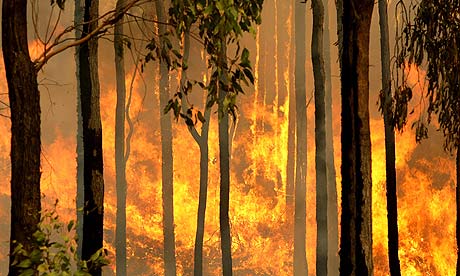Scientist Tim Flannery recalls the long, wet Victorian winters now replaced by a drier and dangerous climate

A bushfire burns in the Kiewa valley towards the town of Dederang, in Victoria. Photograph: Torsten Blackwood/AFP/Getty Images
The day after the great fire burned through central Victoria, I drove from Sydney to Melbourne. For much of the way – indeed for hundreds of miles north of the scorched ground - smoke obscured the horizon, entering my air conditioned car and carrying with it that distinctive scent so strongly signifying death, or to Aboriginal people, cleansing.
It was as if a great cremation had taken place. I didn't know then how many people had died in their cars and homes, or while fleeing the flames, but by the time I reached the scorched ground just north of Melbourne, the dreadful news was trickling in. At first I heard that 70 people had died, then 108. Then 170. While the precise number of victims is yet to be ascertained, the overall situation at least is now clear. Australia has suffered its worst recorded peacetime loss of life. And the trauma will be with us forever.
I was born in Victoria, and over five decades I've watched as the state has changed. The long, wet and cold winters that seemed so insufferable to me as a young boy wishing to play outside vanished decades ago, and for the past 12 years a new, drier climate has established itself. I could measure its progress whenever I flew into Melbourne airport. Over the years the farm dams under the flight path filled ever less frequently, while the suburbs crept ever further into the countryside, their swimming pools seemingly oblivious to the great drying.
Climate modelling has clearly established that the decline of southern Australia's winter rainfall is being caused by a build-up of greenhouse gas, much of it from the burning of coal. Ironically, Victoria has the most polluting coal-fed power plant on Earth, while another of its coal plants was threatened by the fire. There's evidence that the stream of global pollution caused a step-change in climate following the huge El Niño event of 1998. Along with the dwindling rainfall has come a desiccation of the soil, and more extreme summer temperatures.
This February, at the zenith of a record-breaking heatwave with several days over 40C, Melbourne recorded its hottest day ever – a suffocating 46.1C, with even higher temperatures occurring in rural Victoria. This extreme coincided with exceptionally strong northerly winds, which were followed by an abrupt southerly change. This brought a cooling, but it was the shift in wind direction that caught so many in a deadly trap. Such conditions have occurred before. In 1939 and 1983 they led to dangerous fires. But this time the conditions were more extreme than ever before, and the 12-year "drought" meant that plant tissues were almost bone dry.
Despite narrowly missing the 1983 Victorian fires, and then losing a house to the 1994 Sydney bushfires, I had not previously appreciated the difference a degree or two of additional heat, and a dry soil, can make to the ferocity of a fire. This fire was quantatively different from anything seen before. Strategies that are sensible in less extreme conditions, such as staying to defend your home or fleeing in a car when you see flames, become fatal options under such oven-like circumstances. Indeed, there are few safe options indeed in such conditions, except to flee at the first sign of smoke.
My country is still in shock at the loss of so many lives. But inevitably we will look for lessons from this natural tragedy. The first such lesson I fear is that we must anticipate more such terrible blazes in future, for the world's addiction to burning fossil fuels goes on unabated, with 10 billion tonnes being released last year alone. And there is now no doubt that the pollution is laying the preconditions necessary for more such blazes.
When he ratified the Kyoto protocol, Australia's prime minister Kevin Rudd called climate change the greatest threat facing humanity. Shaken, and clearly a man who has seen things none of us should see, he has now had the eye-witness proof of his words. We can only hope now that Australia's climate policy, which is weak, is significantly strengthened.
After ignoring the Kyoto protocol for years, just months ago we committed to a reduction in pollution of a mere 5% by 2020 over 2000 levels, with the possibility of increasing that to 15% if a successful treaty comes out at Copenhagen later this year. Our national goal is a 60% reduction in emissions by 2050, but such targets are easy to articulate if the bulk of the work must be done by future governments.
As the worst greenhouse polluters, per capita, of any developed nation, there is an urgent need for Australians to reduce our dependency on coal. I believe that if we want to give ourselves the best chance of avoiding truly dangerous climate change, we should cease burning coal conventionally by around 2030. No such policy is currently being contemplated. Instead, as perhaps anyone would, Australians have been focusing on the immediate cause of some of the fires.
Rudd has said that the arsonists suspected of lighting some fires are guilty of mass murder, and the police are busy chasing down these malefactors. But there's an old saying among Australian fire fighters — "whoever owns the fuel, owns the fire". Let's hope that Australians ponder the deeper causes of this horrible tragedy, and change our polluting ways before it's too late.
Tim Flannery is a scientist at the University of Macquarie and author of The Weather Makers: The History and Future Impact of Climate Change

No comments:
Post a Comment